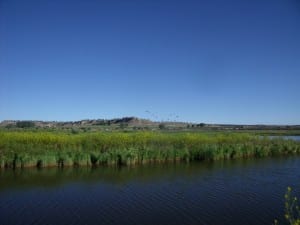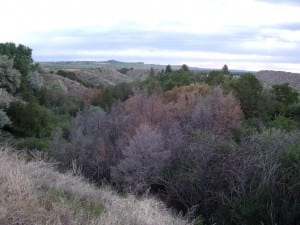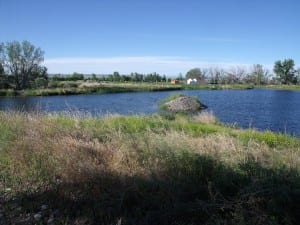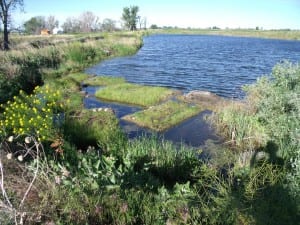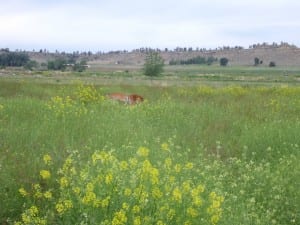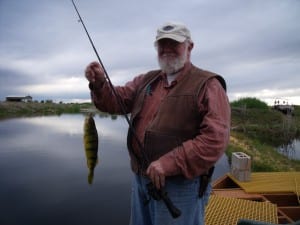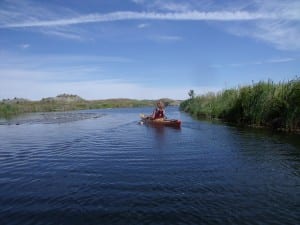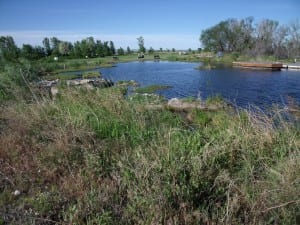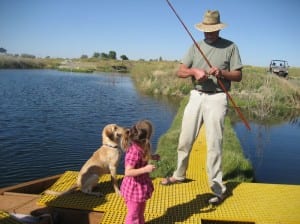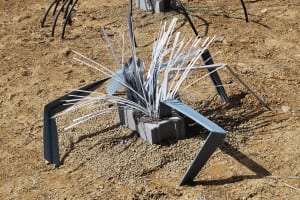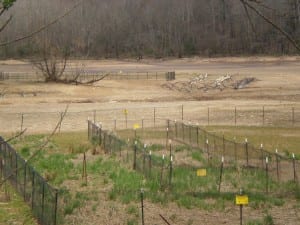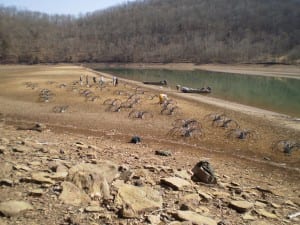Category: Conserv./Envrnmt
Here you can find stories and information about the environment. Conservation efforts across the nation involving all creatures. New green products available will be featured, along with helpful tips do do your part in keeping our rights to hunt and fish for future generations.
Eat more fish to clean your lake?
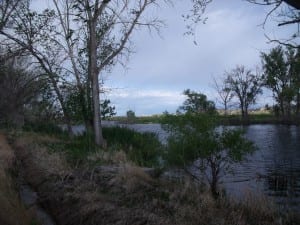 A few weeks ago, my wife Renee’ and I took a trip to Shepherd Montana, headquarters of Floating Island International Inc. We had been invited to stay on the ranch and to see for ourselves how Bruce Kania and his wife Anne, are growing huge fish fast with a woven matrix of inert substrates called BioHaven, or Floating Treatment Wetlands. I had been in contact with Bruce for some time, learning about how excessive nutrients brought in from runoff can be turned into fresh, tasty fish. Not only do the Kania’s grow fish, but frogs, minnows, pheasant, deer and all species of waterfowl prosper in their efforts. Even Yellowstone cutthroat trout flourish in this superior environment, along with crappie and perch and various minnows.
A few weeks ago, my wife Renee’ and I took a trip to Shepherd Montana, headquarters of Floating Island International Inc. We had been invited to stay on the ranch and to see for ourselves how Bruce Kania and his wife Anne, are growing huge fish fast with a woven matrix of inert substrates called BioHaven, or Floating Treatment Wetlands. I had been in contact with Bruce for some time, learning about how excessive nutrients brought in from runoff can be turned into fresh, tasty fish. Not only do the Kania’s grow fish, but frogs, minnows, pheasant, deer and all species of waterfowl prosper in their efforts. Even Yellowstone cutthroat trout flourish in this superior environment, along with crappie and perch and various minnows.
See the dozens of unique artificial fish habitat models, fish attractors and fish cover used at fishiding.com, the leader in proven science based, fish protection.
The setting was breathtaking, Mule deer and whitetail browsing on the thousands of perennial plants Bruce has planted for their benefit and soil stability. Over time these plants die off and return each spring, contributing to the rich organic soils being built up. Sprawling channels and wetlands run throughout the property, slowly beginning to filter and absorb the high levels of nutrients. When the water enters the property, it is dark and cloudy like chocolate.
Ducks of all varieties, geese, snipe, vulture, pheasant and more, have taken up residency in this oasis of prime habitat, with no intention of ever leaving. With Bruce being a veteran trapper, predators are being kept in check, protecting the desired species. With the Yellowstone River along one property line, this place is an outdoorsman’s paradise.
Stewardship of our natural resources is the core of the work being undertaken at Shepherd Ranch. We were there to catch and eat a bunch of these fish, helping them ultimately remove the phosphorus and nitrogen that causes excessive weed growth and poor water quality. Bruce and I dreamed big about someday soon, this concept of abundant, mass fish harvest to clean our Nation’s waters and beyond.
The data shows that over 50% of our Nation’s waterways are considered eutrophic and in trouble, meaning highly excessive weed growth and nutrient concentrations. Dark, stained and sometimes smelly water are all results of an unbalanced system. More information about our Nation’s waters are available on the National Fish Habitat Action Plan website, a wealth of details everyone is affected by.
When we began producing artificial fish habitat products made from reclaimed PVC siding called Fishiding, the ability to grow algae immediately on the inert surface area, appealed to the fisherman. Like myself, the average fisherman understands that habitat with good algae growth seems to hold more fish. It wasn’t until reading more and talking to Bruce that I began to understand the big picture of why this holds true.
These nutrients stick to surfaces underwater and create the beginning of the food chain called periphyton. Many forms of this wonderful natural, filter and food factory are present. Algae, bacteria, fungi, protozoa, zoo plankton and other invertebrates, function as a community highly efficient in capturing and processing nutrients. When I say processing, this means turning it into food of the highest quality found on earth. The more fish graze on it, it grows faster, decreasing bio mass and the fish grow at alarming rates, making the water clearer.
Numerous types of periphtyon are present, some require light to thrive and some do best in the dark. The more surface area available, the more periphyton can grow and work its magic. Pretend the floating island is a supermarket, the more shelves available the more food can be stocked for consumption. Small fish and fry eat this “super food” until about age one, when they begin to forage on larger minnows and bugs. Periphyton is the “mother’s milk” needed to start life full of nourishment.
This process has been perfected in second and third world countries. We are lacking in knowledge here in the states, but it’s improving with over 4400 of these floating treatment wetlands installed here and worldwide.
Think about all the ponds and lakes in your area. Golfcoarse ponds, retention ponds, private and public, there are many. Some are clear and deep with a balanced mesotrophic or oligotrophic eco system. The other 50% eutrophic waters, could be teaming with fish and every citizen is asked to help keep them clean…..by catching as many fish as you can eat, and removing them! The fish also reproduce faster than normal, so there is no worry of running out. Fish Fry Lake is living, thriving proof of this for all to see. Renee’ and I caught over 500 fish in less than eight hours of fishing. If your hook was in the water, it was being attacked by one or more gorgeous perch or crappie. From 6-8” one year olds, to 12-14” plus jumbos! Remember, this is in Montana not Lake Michigan, the only other place I have ever seen perch of this size. Perch and Crappie were abundant to say the least, with a perch containing about one percent live weight of phosphorus. The name “Fish Fry Lake” more than lives up to its name. Remember, this works with no chemicals, win,win,win…….
This natural cause and effect has other uses too. Bioswales also made by FII, are used in ditches and swales to slow down erosion as water runs through it, similar to adding hay bales in a ditch after new construction. The difference in using the inert matrix, patented by FII, is that as the bioswales slow down the water, the periphyton forms and begins to consume the over abundant nutrients, cleaning the water as it passes through slowly. Unlike the hay bales, the matrix never breaks down, which would add to the nutrient load in the waterway. Same with weeds, as they decompose, they remove oxygen from the water and add fertile organic matter that acts like fertilizer. Inert substrates like the matrix material used in the Floating islands, never breakdown and keep working year round to feed the fish and clean the water.
One of the optimal ways that FTWs can transition nutrients from water to beneficial use is to grow bacterial biofilm rather than floating algae. Bacterial biofilms grow faster than algae when their limiting parameters are satisfied, and when they have adequate circulation and surface area for growth. With appropriate stewardship, they also are an improved primary food source for fish (Azim 2005).
Circulation increases bacterial efficiency by bringing nutrients such as dissolved oxygen, nitrogen and phosphorus to the biofilm.
A single 1000-square-foot BioHaven Floating Island can provide over 18 acres of strategic “concentrated wetland effect” surface area.
As demonstrated in field-scale case studies, waterways containing FTWs remove contaminants (pollutants) such as ammonia, total nitrogen, total phosphorus, Total Organic Carbon (TOC), Biochemical/Chemical Oxygen Demand (BOD/COD) and total suspended solids (TSS). These studies have included municipal wastewater, storm water, lakes and agricultural runoff. FTWs have demonstrated the ability to simultaneously remove all of these contaminants, due to their complex biofilms containing both aerobic and anoxic bacteria.
Dissolved oxygen (DO) levels are higher when inert substrate are used rather than organic substrates like wood, due to oxygen consumption during organic carbon uptake by biofilms. Inert substrates like BioHaven polymer matrix, can provide a more precise ability to initiate movement of a waterway’s nutrient load up the food chain. Periphyton moves nutrients up the food chain better than does synthetic fish food.
The bottom line is this. To ultimately remove these unwanted nutrients, fish have to be harvested. Not all lakes have these issues, but in Eutrophic lakes, the fish contain these nutrients and have to be caught and eaten to keep up with the periphyton growth. A perch for example, contains about 1% live weight of phosphorus. By removing enough fish to equal one pound of this chemical which is safe for humans and needed for strong bones, about 700 pounds of aquatic vegetation never gets a chance to grow. No chemicals or weed harvesting just fishing and keeping them for the table. Would you be willing to help clean your neighborhood pond by catching and eating some fresh fish? It’s a reality and is being performed at an alarming rate at Fish Fry Lake. We flew home with only one checked bag, 50 pounds of fresh fillets.
Clean water entering the Yellowstone River and ultimately the Mississippi, Stewardship is the lesson to be learned.
Fishing Out Phosphorus
| Researchers at Floating Island International (FII) in Shepherd, Mont., an agricultural region, are fishing nonpoint source nutrients out of 2.6-ha (6.5-ac) Fish Fry Lake. Bruce Kania, FII project development director, uses rod and reel to maintain floating treatment wetlands (FTWs) in the lake. Fishing is all part of the job; experienced anglers can catch one fish every 2 minutes at Fish Fry, he said. | |
 | The man-made floating islands transfer excess phosphorus from host water to periphyton, which is a colony composed of algae, bacteria, microbes, and organic matter. This colony serves as a food source for certain types of fish.In 2011, Fish Fry Lake removed 1.1 kg/ha (1 lb/ac) of phosphorus at a cost of $282/kg ($128/lb) and produced 112 kg/ha (100 lb/ac) of harvestable fish, Kania said. The lake’s clarity, measured by Secchi disk, improved to 5.8 m (19 ft) from an initial condition of 0.4 m (1.2 ft) with ongoing removal of suspended solids, according to FII. As of May, data indicate nutrient removal and catch rates are on their way to doubling in 2012, Kania said. |
| |
| FTWs offer effective, cost-efficient additional treatment to increase nutrient removal. Application is universal — they are operating in various climates. FII has 4400 FTWs installed in such places as New Zealand, where water quality managers grow eels to restock other waterways, and in Singapore, Indonesia, and across the United States, including Alaska. The islands hold fast, surviving typhoons, tornados, and active icy waters, Kania said.Data show that FTWs have vast potential to address water quality and promote aquaculture. “We’re trying to answer the question, ‘Can we engender a viable fishery … to ultimately improve water quality?’” Kania said. | |
| According to FII research, FTWs remove 93% of total suspended solids, 88% of phosphorus, 71% of total nitrogen, 88% of total organic carbon and chemical oxygen demand, 90% of copper, 95% of lead, and 36% of zinc. The data indicate that FTWs exceed removal rates of most comparable best management practices, such as retention ponds, wetland basins, media filters, and other manufactured devices.FTWs reduce algae, engender fish by growing periphyton and other biofilms, improve pond aesthetics, cool water, provide shade, and grow plants. FTWs can be used for effluent polishing, stormwater management applications, and lake restoration, Kania said. | |||
 |  | FTWs can help a community facing increased effluent standards. “FTWs can be installed into existing [wastewater] lagoons to improve the contaminant removal rates, thereby resulting in cleaner effluent,” said Frank Stewart of Stewart Engineering (Bozeman, Mont.), who is an engineering design consultant for FII. “In most cases, installing FTWs into existing lagoons is cheaper than building new lagoons, especially if land costs are considered,” he said. | |
 |
| ||
| FTWs also could reduce peak discharges for occasional out-of-compliance wastewater dischargers, as well as decrease the volume of nutrients generated by livestock lagoons, Stewart added.Half the Cost While the systems do not work well in urban areas because of site restrictions, cities can get credit for contaminants removed from smaller upstream communities. “The cleanup effect for the river is the same, but the removal is much cheaper,” Stewart said. According to Mark Reinsel of Apex Engineering (Missoula, Mont.), who establishes testing protocols and analyzes FII water data, FTWs cost less than 50% of traditional treatment, including alum. Floating islands cost between $269 and $484 per m2 ($25 and $45 per ft2), depending on whether aeration is incorporated. Plants, which increase longevity and stability, increase costs. See the dozens of unique artificial fish habitat models, fish attractors and fish cover used at fishiding.com, the leader in proven science based, fish protection. Biofilm and periphyton love dirty water — the more of it in contact with the matrix, “the faster the biofilms remove contaminants,” Stewart said. Adding aeration increases DO concentrations due to mixing, lowers overall water temperatures, and hastens periphyton growth, researchers explained. With increased sunlight and circulation, FTWs increase in size and density. As periphyton takes in phosphorus and transfers it to the fish that feed on it, DO levels rise and turbidity decreases. Sunlight reaches into lower levels of the water column, enhancing diatom?based periphyton growth. As FTWs grow, they become more diversified and stable, enabling them to remove more phosphorus and generate larger fish populations. One aerated 230-m2 (2500-ft2) model in Fish Fry Lake circulates up to 2 m3 (72 ft3) of air per minute and 40 m3 (10,400 gal) of direct flow with a 2.25-kW (3-hp) motor. FTWs with aeration destratify the 8.5-m-deep (28-ft-deep) lake and homogenize temperatures when needed, Kania said. | |
Efficiency and Design Life According to Reinsel, FTWs “are more effective than treatment methods that are relying on settling.”Reinsel measures effectiveness in pounds of phosphorus per year per cubic foot of FTW. Rain gardens and stormwater retention basins are 20% to 30% effective, while the floating islands are 60% to 70% effective, he said. Data on design life are sparse — FII’s oldest floating island is 8 years old. After 20 to 30 years, an FTW may have to be harvested. The Art of FTW Maintenance |  |
| |
| Other than all that fishing and frying, Stewart said FTWs are easy to manage.“Relative to eutrophied waters, catch-and-harvest needs to be the new mantra,” Kania said. | |
Area golf courses filled with fish
Most of the world’s best golfers this week gather at the TPC Sawgrass Players Stadium Course in Ponte Vedra Beach. They’re there to tackle undulating and tricky greens, tough bunkers, tight fairways, and water hazards full of gators, snakes and sometimes round white balls.
But also on the agenda of some of those elite golfers is fishing in the ponds, lakes, lagoons and famous water hazards in and around the Stadium Course. Those waters are loaded with fish, including largemouth bass the size of newborn babies. The Sawgrass complex of lagoons and other watery spots is chock full of heavyweight bass, many weighing well more than 10 pounds, and fish to 15 pounds have been caught.
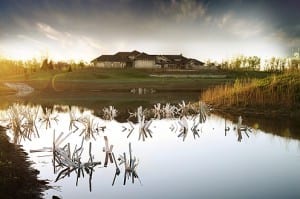
Those are truly world-class fish that many anglers in many places would pay a bundle to hook.
Often before or after a practice round, or a tough day in the rough, players such as Davis Love III, Tiger Woods, Boo Weekley, Greg Norman, Mark O’Meara and many others have been known to hang up a graphite driver in favor of a graphite casting rod at The Players.
The bass fishing is so good in waters at the Stadium Course that years ago it was voted the best for big bass by elite PGA Tour fishermen. See the dozens of unique artificial fish habitat models, fish attractors and fish cover used at fishiding.com, the leader in proven science based, fish protection.
A poll was taken among the golf pros who fish different courses on Tour to learn which of the many places they visit offers the best fishing. The Stadium Course won by a wide margin.
Only players with PGA credentials, very special guests and perhaps course residents are allowed to fish Stadium Course waters, especially during the tournament. But area anglers should take a tip from the golfers that some of the best and most consistent fishing that anglers could ever hope for can be found in the water hazards and nearby ponds and lakes of golf courses.
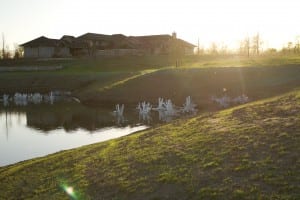
Not only do golf course waters have bass, but many are loaded with bluegills, crappies and catfish. In coastal regions, often saltwater species seep into the freshwaters or tidal waters of golf courses. Plenty of golf courses in Florida, Georgia and the Carolinas are full of fish such as red drum, flounder, baby tarpon, snook, ladyfish, black drum and other species.
While great fishing can be discovered in golf course waters, it’s probably wise not to eat fish caught from them because of the pesticides and fertilizers used on nearby turf. Nevertheless, for fun catch-and-release fishing, few places offer better action than golf course waters.
Getting permission to fish golf ponds can be challenging, particularly on private country clubs — which frequently offer the best action. But it’s worth the effort gaining access. Sometimes meeting and talking with the club pro is worthwhile. Explain you’ll not interfere with golfers on the course, and all fish will be released unharmed. Some golf courses are closed on Mondays, which is a prime time to fish their waters, and permission to fish is more easily obtained then. Dawn, dusk and night fishing is worthwhile because golfers are not on courses, and anglers don’t interfere with play.
In many golf course communities, residents and their guests are allowed to fish, so it pays to make friends with golfers. Golf resorts are popular vacation spots, and guests often have permission to fish water hazards as long as they don’t hamper golf play.
In large golf Meccas, frequently several courses are available, and many feature large, wandering connected ponds and creeks that snake around the area. Many such waters appear small, but instead might cover hundreds of acres, with many places surrounded by overgrown vegetation that’s ideal fish habitat.
Sometimes small, lightweight johnboats, canoes, kayaks and float tubes can be put in, which allows anglers to get far away from golfers and other people — to waters rarely fished. Electric fishing motors often are allowed on boats in golf course communities.
At some golf resorts, angling by visitors is encouraged on water hazards, to the point that improved boat ramps are available, and large bass boats even can be launched and used for fishing. Usually, no big outboards can be used, however, only quiet electric motors.
An important plus for golf course waters is that most are small, shallow, and have limited fishing pressure. Therefore, it takes comparatively little time for anglers to locate fish. More often than not, course ponds and lakes were dug by construction crews for use as fill when building greens, tees and bunkers.
Consequently, water hazards commonly have great structures such as holes, underwater islands, humps, bars, tapering points and drop-offs. Some golf ponds are mini-reservoirs, complete with creek channel edges, flooded timber and stumps, riprap and deep dam water.
In some shallow, natural golf course waters there is no well-defined structure to hold fish. In such waters, the outside edges of grass lines and lily pads might hold almost every fish in the lake or pond. Sometimes, ponds have deep undercut banks that harbor big bass and other species, particularly in sunny weather. Find a cool, shady bank with overhanging willows or other trees and you might have discovered the best fishing spot on an entire water hazard.
Bulkheads around greens and near fairway bunkers, and small footbridges for golf carts over water hazards, also can be outstanding fishing spots. I once stopped on such a bridge on a public Florida golf course and looked down into the shadows, hoping to see bass or bream.
Instead, I spotted a school of about a dozen catfish, none less than 10 pounds.
A little schmoozing of the club pro got permission to fish for the cats, and that afternoon friends and I worked them over using baits on bottom. We caught over a dozen hard-fighting channel cats, including one behemoth pushing nearly 20 pounds.
We released every cat, and have several times since fished the same water hazard — no doubt landing and releasing some of the same catfish over several years.
Not once have we seen another angler working the same spot, though many dozens of golfers cross the bridge daily.By Bob McNally
United We Stand—In Support of Fish Habitat
 The new box culvert and open channel to Long Island Sound, which restored fish passage and tidal flows to the salt marsh. Volunteers installed the dune grass plantings.
The new box culvert and open channel to Long Island Sound, which restored fish passage and tidal flows to the salt marsh. Volunteers installed the dune grass plantings.We have a lot to learn from nature about teamwork. In fact, natural systems prove time and again that the intricate partnerships between air, water, soil, nutrients and plant and animal species breed success. So why, whether a singular agency, organization or landowner, would we ever think that we could “fix” a problem like fish habitat degradation alone? See the dozens of unique artificial fish habitat models, fish attractors and fish cover used at fishiding.com, the leader in proven science based, fish protection.
Well, we’re not trying to do it alone anymore. Just this week, I was able to represent USDA’s Natural Resources Conservation Service (NRCS) and speak to a nationwide group of conservation partners about how we follow nature’s lead and partner for impact.
We were gathered at The Nature Conservancy headquarters to celebrate the Memorandum of Understanding between the Departments of Agriculture, Commerce and Interior to implement theNational Fish Habitat Action Plan (NFHAP). This is a plan that leverages partnerships for collaborative, science-based conservation that yields results for species recovery and sustainability—a priority for NRCS.
NFHAP steers federal resources towards voluntary conservation strategies developed by grassroots fish habitat partnerships. The plan works by combining federal, state and private funding sources to achieve the greatest impact on fish populations through priority conservation projects.
Last spring in Long Island Sound, we and our partners restored tidal flow to a 78-acre tidal marsh by removing metal culverts—barriers to fish passage—and reconnecting 3 miles of stream to Bride Lake, a lake that now provides spawning habitat for river herring. In the second operating season, an electric fish counter recorded almost 197,000 river herring passing through the newly opened channel.
This project was a huge success thanks to the partnership efforts of the Connecticut Department of Energy & Environmental Protection, U.S. Fish & Wildlife Service, National Oceanic and Atmospheric Administration and Connecticut Fund for the Environment: Save the Sound.
 The small alewife species of herring swimming up the newly opened channel to spawn in Bride Lake.
The small alewife species of herring swimming up the newly opened channel to spawn in Bride Lake.This is only one example of the hundreds of ongoing projects fostered through the National Fish Habitat Partnership action plan. And NRCS is pursuing many exciting opportunities like this every day. The partnership approach stretches public dollars further because it engages the private sector in helping tackle shared priorities while connecting local conservation partnerships to achieve the best possible results. By combining resources we are increasing “boots on the ground” in priority areas to make a measurable impact.
Today, I followed up with our partners to outline the upcoming actions NRCS is taking on both the east and west coasts in support of the partnership. In Puget Sound, on Washington’s coast, we are making additional commitments to protect and build habitat for the Pacific salmon. In Long Island Sound, we are making resources available for efforts to restore shellfish habitat and oyster populations decimated during hurricane Irene.
At NRCS we are about not just the health of soil, air and water, but also the living ecosystems that make our natural resources so significant. Working lands and living waters create natural partnerships between the communities of sportsmen, agriculturists, environmentalists and wildlife enthusiasts. There is a place in nature for all of us to come together—starting with conservation partnerships! Posted by NRCS Assistant Chief James Gore
Low cost inert substrates for growing bio film
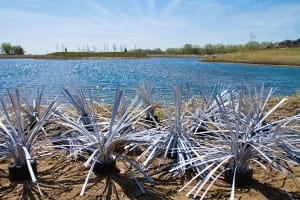
At Fishiding.com we specialize in turning reclaimed PVC into long term products for fish habitat, nutrient removal and producing fish food. The amazing factor in this process is as Green as it gets, with no additional manufacturing or carbon footprint associated with our processes.
Our material comes to us through a network of suppliers, environmentally aware of the desire to keep this material out of landfills and put to good use. In this growing world, we as stewards of nature, must continue to find practical ways to re-use these post consumer products. Protection for aquatic life and growing it’s food, simultaneously, year round. Read below to see how it works, by the leaders in this technology to see if you need: Floating Islands International,Inc. to give you a hand with your water quality questions and needs.
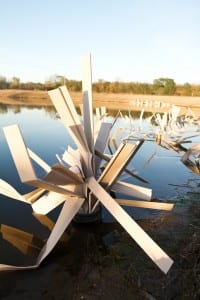
 Trading Nutrients for Fish by Bruce Kania (courtesy of Pond Boss magazine www.pondboss.com)
Trading Nutrients for Fish by Bruce Kania (courtesy of Pond Boss magazine www.pondboss.com)
Fish productivity is enhanced by surface area. When biofilms accumulate on substrate, excess nutrients in the water are used up as the biofilm grows. This in turn feeds the food chain, and leads to bigger and more numerous fish. Catching these fish represents a great way to remove phosphorus permanently from water. Please scroll to page 10 to view the article. Pond Boss magazine is dedicated to managing private waters for fish productivity
Fishiding.com offers products for many different applications in a vast array of sizes. Pieces ranging from 1/4″ wide up to full panels reaching 10″-12″ in width and as long as 12 feet. Many different shapes and textures of substrates for fish habitat as well as unlimited varieties of installation options for hatchery and aquaculture use. It all comes down to providing the correct amount and enough of surface area to handle the load of each individual waterway or volume of bio film needed. See the dozens of unique artificial fish habitat models, fish attractors and fish cover used at fishiding.com, the leader in proven science based, fish protection.
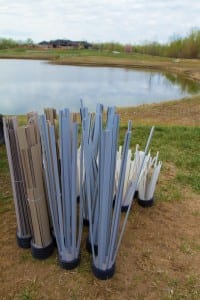
By utilizing post consumer materials, the cost of these unique substrates runs far less than other manufactured products available. When sold in bulk shipments loose, these strands or limbs of textured PVC can cost pennies per square foot of surface area. Strands with or without holes are available to hang or tie groups of substrate sizes together. Self contained and weighted, optional units come ready to bend to shape and toss in water, running slightly higher in price. Available pieces from stiff and rigid “sticks” to soft flexible strands in many colors, lengths and varieties.
Contact David to discuss your needs and receive a custom quote for your project. Shipped worldwide this new understanding of feeding your fish, creating habitat and purifying the water, is gaining much deserved attention.
Stewardship starts with you, for future generations.
David@fishiding.com 815-693-0894
ASA: Secretaries Salazar, Vilsack And Bryson Come Together To Improve Fish Habitat Nationwide
by Outdoor Hub News

The sportfishing industry applauds the Secretaries of Interior, Agriculture and Commerce who signed a Memorandum of Understanding (MOU) to promote interagency collaboration on the implementation of the National Fish Habitat Action Plan (NFHAP), a science-based partnership that seeks to protect, restore and enhance fish habitat on a range-wide scale. The agreement will streamline agency efforts and ensure that federal resources are employed in the most effective and efficient manner possible.
The NFHAP was established in 2006 in response to the declining condition of waterways and fish habitat across the country. Through 18 Fish Habitat Partnerships, federal, state, tribal, local and private interests collaborate to conserve and restore fish habitat. This non-regulatory initiative is the most comprehensive effort ever attempted to voluntarily conserve freshwater, estuarine and marine habitats nationwide.
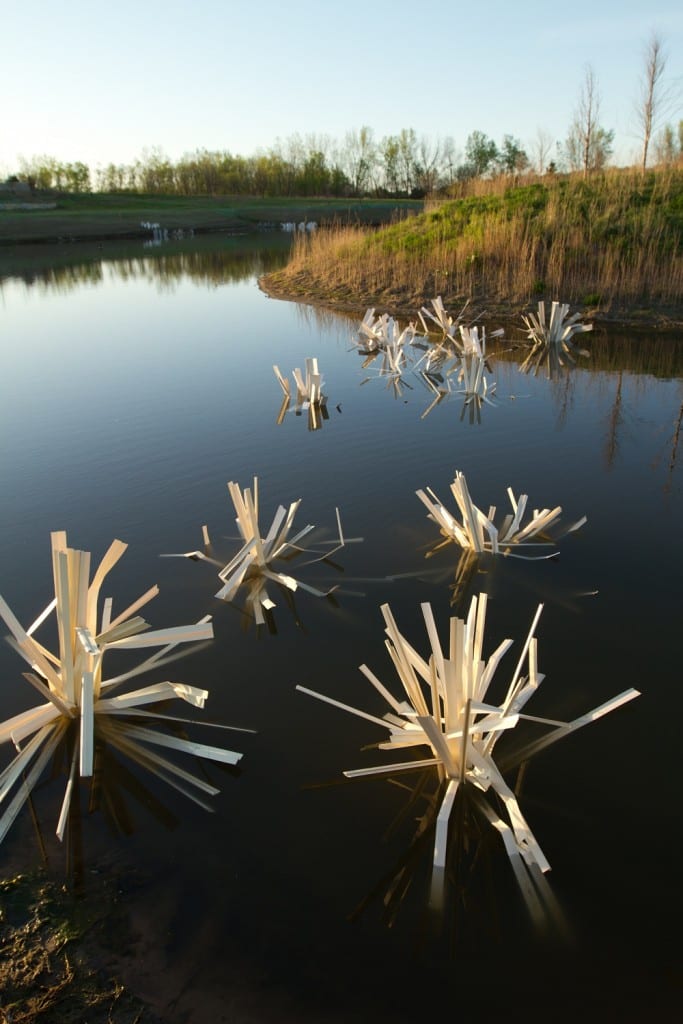
“The recreational fishing community is committed to the conservation and improvement of our waterways and it is gratifying to see the Administration strengthen its commitment to the NFHAP as well,” said Gordon Robertson, American Sportfishing Association vice president. “Our aquatic resources play a large role in the quality of our lives. Healthy waterways and robust fish populations are vital to the well-being of our society and sustainable fisheries, providing recreation, clean water, food and more.”
“This is a big step for our federal partners, who see the value of our strategic approach to conserving fish habitat,” said Kelly Hepler, chair of the National Fish Habitat Board who is also with the Alaska Department of Fish and Game. “Our coordination and involvement with federal agencies has really grown since 2006 and I think today marks a significant day in recognizing that.”
“The NFHAP not only conserves our waterways and fishery resources, it fuels a great economic engine,” said Mr. Robertson. “Recreational fishing has a $125 billion impact on our nation’s economy. The economic, social and conservation benefits of recreational fishing would not be possible without the commitment made by programs like NFHAP to ensure our nation’s waterways are clean, healthy and abundant with fish. Over the years, NFHAP has proven that a small federal investment will benefit all Americans and the resources that we depend on for livelihood and leisure.”
See the dozens of unique artificial fish habitat models, fish attractors and fish cover used at fishiding.com, the leader in proven science based, fish protection.
Between 2006 and 2010, the U.S. Fish and Wildlife Service provided $12 million to support 257 on-the-ground conservation projects in 42 states, leveraging $30 million in partner match, to address the priorities of the Fish Habitat Partnerships. This investment in turn creates jobs and provides economic benefits as results of healthier waterways and increased recreational fishing activity. Investment in the NFHAP since 2006 has generated nearly $1 billion in value and supported over 20,000 jobs. That is a return of over $20 for every dollar spent and one job supported by every $2,400 invested.
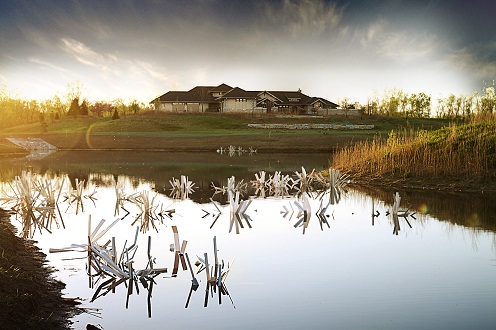
“Our next step is to have Members of Congress get on board with this important initiative,” said Mr. Robertson. “The National Fish Habitat Conservation Act (S.1201), introduced by Sen. Lieberman (I-Conn.), will formally authorize and establish a funding source for the NFHAP, providing much needed support for aquatic habitat restoration and conservation across the U.S. Together with the support of the Administration and Congress, we can expand upon the tremendous strides already made by NFHAP in restoring our nation’s waterways.”
WVBFN leads by example for the B.A.S.S. Federation Nation with Fishiding artificial fish habitat
 If you want to grow and sustain your fishery, then you have to expand the habitat for fish to reproduce and grow large. This is nothing new for the fisherman involved in the B.A.S.S. Federation Nation of West Virginia. These guys have been involved in habitat restoration projects from the beginning, leading the way for future generations of fish and fisherman to grow and prosper.
If you want to grow and sustain your fishery, then you have to expand the habitat for fish to reproduce and grow large. This is nothing new for the fisherman involved in the B.A.S.S. Federation Nation of West Virginia. These guys have been involved in habitat restoration projects from the beginning, leading the way for future generations of fish and fisherman to grow and prosper.
A few short weeks ago, Jerod Harman, Conservation Director for the West Virginia B.A.S.S.Federation Nation, contacted the owner of Fishiding artificial habitats. Jerod saw the benefits of these reclaimed PVC structures and asked about working together to help them in their ongoing efforts to improve fish habitat on a few of their local lakes.
See the dozens of unique artificial fish habitat models, fish attractors and fish cover used at fishiding.com, the leader in proven science based, fish protection.
Fishiding habitat products had been recently been awarded at the Bassmasters Classic Conservation Summit in Shreveport,LA. Jerod, a long time steward of B.A.S.S knew these reclaimed structures would help achieve their habitat goals, complimenting the “Spider Blocks” he is so well known for installing. Jerod has a long time relationship with local Corps of Engineer leaders and the DNR in his outstanding state. Having worked with them for many years on multiple restoration projects, his reputation is well known for rounding up the troops and getting the job done in an utmost professional and timely manner. Field and Stream magazine has also highlighted his work in a recent issue, honoring him as one of our Nation’s “Hero’s of Conservation” for his habitat work.
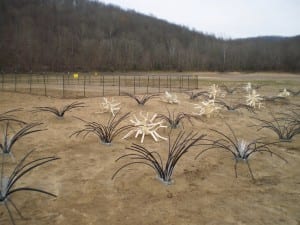 When the local lakes are drawn down for the winter, Jerod and his dedicated team of volunteers spring into action when most of us are sitting by a warm fire. The exposed lake bed gives them the opportunity to get right into the fishes’ favorite breeding grounds and begin to work their magic. In past years, the group has braved snow, ice and freezing temperatures to work on structures to provide habitat that is either lacking, has deteriorated or washed away by flooding. The group typically works with artificial structures that will last for many years to come, since they never rot or decompose like other types of natural products. They also install native plants and protect them from predators until they have a chance to take hold.
When the local lakes are drawn down for the winter, Jerod and his dedicated team of volunteers spring into action when most of us are sitting by a warm fire. The exposed lake bed gives them the opportunity to get right into the fishes’ favorite breeding grounds and begin to work their magic. In past years, the group has braved snow, ice and freezing temperatures to work on structures to provide habitat that is either lacking, has deteriorated or washed away by flooding. The group typically works with artificial structures that will last for many years to come, since they never rot or decompose like other types of natural products. They also install native plants and protect them from predators until they have a chance to take hold.
Jim Summers is another name synonymous with habitat. Jim has worked on these types of projects for many years and now takes credit for the fine photos we have to enjoy. Jim is always on hand to help, as well as get the shots as the work progresses. Some of the WVDNR staff put on their wet suits on their own time to get the underwater pictures of the spider block structures after they had time to age. The proof is in the pictures, showing not only bass, but forage species utilizing the new habitat the group has provided and installed.
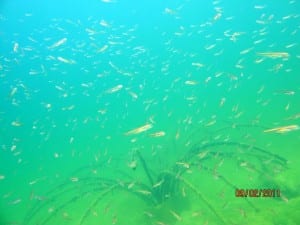
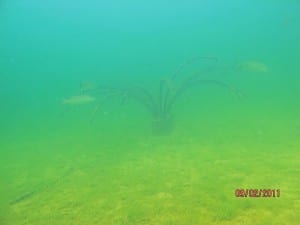 The key to the effectiveness of artificial fish habitat, is the ability to grow bio film or periphyton. This film forms on inert substrates and begins the cycle of life which attracts invertebrates and larger fish to feed on. Other aspects that hold these types of structure units above the rest is that they don’t decompose, therefore not using up important dissolved oxygen from the water column as they rot. Bio film is proven to be the highest form of fish food, better than any commercial feeds on the market today. The bio film consumes over abundant nutrients like phosphorous, brought in by runoff which causes excessive algae growth in many lakes and ponds. The fish then eat this high energy food and grow even larger, at an unmatched rate to boot! A company leading this technology is Floating Islands International,Inc out of Montana. These islands made from recycled plastics form a matrix of fibers, creating maximum surface area to grow this bio film. Not only do these products feed the fish, but they cleanse the water and drastically improve water clarity.
The key to the effectiveness of artificial fish habitat, is the ability to grow bio film or periphyton. This film forms on inert substrates and begins the cycle of life which attracts invertebrates and larger fish to feed on. Other aspects that hold these types of structure units above the rest is that they don’t decompose, therefore not using up important dissolved oxygen from the water column as they rot. Bio film is proven to be the highest form of fish food, better than any commercial feeds on the market today. The bio film consumes over abundant nutrients like phosphorous, brought in by runoff which causes excessive algae growth in many lakes and ponds. The fish then eat this high energy food and grow even larger, at an unmatched rate to boot! A company leading this technology is Floating Islands International,Inc out of Montana. These islands made from recycled plastics form a matrix of fibers, creating maximum surface area to grow this bio film. Not only do these products feed the fish, but they cleanse the water and drastically improve water clarity.
 Generally, the group of volunteers will install 50-75 habitat units per outing. Much of the supplies are donated by local companies, providing pipe, cinder blocks and cement. Some of the funds are received from state and federal grants, to provide plant stock and professional help as well. The bulk of the effort comes from volunteer labor, provided by Jerod and his dedicated group of conservation minded members. Without folks like these, our grand kids would not have the opportunity to enjoy what we have been so blessed to enjoy for so many years.
Generally, the group of volunteers will install 50-75 habitat units per outing. Much of the supplies are donated by local companies, providing pipe, cinder blocks and cement. Some of the funds are received from state and federal grants, to provide plant stock and professional help as well. The bulk of the effort comes from volunteer labor, provided by Jerod and his dedicated group of conservation minded members. Without folks like these, our grand kids would not have the opportunity to enjoy what we have been so blessed to enjoy for so many years.
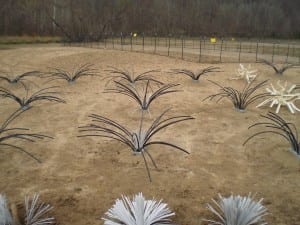 The most recent projects involving the donated fishiding structures were put in Lake Summersville and Sutton Lake. These two area lakes will benefit in many ways from the Federation’s efforts. Spider Blocks, along with Keeper, Safehouse and shallow Cradle models all work together near new bullrush and arrow anum plantings to provide ultimate spawning areas.
The most recent projects involving the donated fishiding structures were put in Lake Summersville and Sutton Lake. These two area lakes will benefit in many ways from the Federation’s efforts. Spider Blocks, along with Keeper, Safehouse and shallow Cradle models all work together near new bullrush and arrow anum plantings to provide ultimate spawning areas.
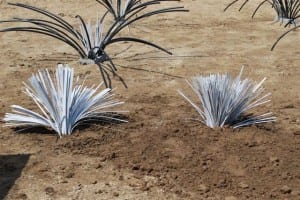 1800 plants were added to Sutton lake by volunteers from the WVBFN as well as local DNR officials and staff. David Truban, a West Virginia DNR commisioner was also on hand to bend a few Fishiding structures too. Jerod told Dave, “Just think like a fish and have at it” He was pleased to put his twist on making one into a fantastic looking block! ” I honestly believe that this project will make huge a difference in this area of the lake because of the diversity of habitat that they will have at theit disposal. “If I were a bass, this is where I would want to call home”
1800 plants were added to Sutton lake by volunteers from the WVBFN as well as local DNR officials and staff. David Truban, a West Virginia DNR commisioner was also on hand to bend a few Fishiding structures too. Jerod told Dave, “Just think like a fish and have at it” He was pleased to put his twist on making one into a fantastic looking block! ” I honestly believe that this project will make huge a difference in this area of the lake because of the diversity of habitat that they will have at theit disposal. “If I were a bass, this is where I would want to call home”
“I really don’t see us doing projects in the future without artificial structures mixed in. No matter what the weather conditions are, they are an investment that will be there through freezing, drought, high water, just about anything barring a massive flood in which they would be washed out. And even then, they will just be redistributed for cover somewhere else. ” Jerod Harman.
Working with the WVBFN has been an absolute pleasure. Cribs were sent out to the guys early in the week and by the weekend, they were in place ready for the water to rise. Others can take note of the dedicated members, the communities involvement and the ongoing positive relationship formed with the local governing agencies. These fish will prosper from their combined efforts, ultimately providing fisherman with a vast variety of cover and species to target.
For more information about the WVBFN and it’s affiliates you can go to their website at http://www.wvabassfederationnation.com . To get involved in their habitat efforts you can contact Jerod Harman at jharman12@cebridge.net
Detroit River fundraiser to highlight restoration projects
WYANDOTTE — Friends of the Detroit River extends an invitation to get together March 31 at the Wyandotte Boat Club for the annual Detroit Riverkeeper fundraising dinner.
The goal of the dinner is to raise funds to help support the Detroit Riverkeeper program and the patrol work that Riverkeeper Robert Burns does along the Detroit River.
The dinner will be held at the rowing club’s facility in the Wyandotte Boat Club’s second-story banquet room, which overlooks the Detroit River. The facility is at 1 Pine St, east of Biddle Avenue and south of Eureka Road, across from the Portofino restaurant parking lot.
Doors open at 6 p.m. for socializing, followed by a catered dinner at 7 p.m.
Friends of the Detroit River is a nonprofit organization dedicated to protecting and improving the waters and habitats along the river’s watershed.
After dinner, a presentation will be given on three Great Lakes restoration projects the group is working on along the Detroit River.
See the dozens of unique artificial fish habitat models, fish attractors and fish cover used at fishiding.com, the leader in proven science based, fish protection.
According to Burns, the group received $3.2 million in grants on behalf of the Detroit River Area of Concern’s Public Advisory Committee from the U.S. Environmental Protection Agency’s Great Lakes Restoration Initiate funds to do the projects. Two of them are on Belle Isle and one is along the shoreline of U.S. Steel-Great Lakes Works’ facility in Ecorse and River Rouge.
The first project on Belle Isle will be at the south fishing pier, just below the Coast Guard station, and will involve the creation of a fish habitat area behind the pier, along with some shoreline restoration.
The second Belle Isle project will be to open up the landlocked Blue Heron Lagoon lake, at the upper end of the island, to the river.
“This will allow fish from the river to be able to access this 40-acre shallow wetland lake, adding valuable fishing habitat for spawning and a nursery area for fish that hatch in the upper river,” Burns said.
The third project is between the Great Lakes Steel Boat Club and the 80-inch rolling mill on the U.S. Steel site. Burns said this shoreline has some natural features on a section of the site not being used by the facility.
“The project is currently proposing to enhance an existing 300-feet rock shoal that will provide additional fish habitat,” he said. “The shoreline will also be enhanced with emergent native vegetation, and about five acres of upland area will be replanted with native trees, bushes and vegetation to provide habitat for local wildlife and migratory birds.”
All three projects are expected to begin by this summer.
The fundraiser will include a cash bar, music, a raffle and a silent auction. Advance tickets are $50 per couple, $30 for a single ticket and $15 for children.
“Come join us for a pleasant evening of networking and socializing,” Burns said.
For more information about the event and to purchase tickets, call 1-734-675-0141 or visitdetroitriver.org.By Jim Kasuba
U.S. Secretaries Agree to Help Conserve Fish Habitat
 The U.S. Secretaries of Commerce, Interior, and Agriculture have made a joint commitment to work together to promote collaborative, science-based conservation of our waterways and fisheries. They will sign an agreement which will focus on partnership-based conservation efforts through the National Fish Habitat Partnership.
The U.S. Secretaries of Commerce, Interior, and Agriculture have made a joint commitment to work together to promote collaborative, science-based conservation of our waterways and fisheries. They will sign an agreement which will focus on partnership-based conservation efforts through the National Fish Habitat Partnership.
The agreement uses federal resources to help state and local governments, landowners, and community groups conserve the places that provide recreation and power our economy.
“Through the strategic use of limited resources—such as the Fish Habitat Partnerships established under the National Fish Habitat Action Plan—we can identify the most effective use of resources to conserve habitats vital to our coastal and marine fisheries, which contribute more than $70 billion annually to the U.S. economy,” said Eric Schwaab, NOAA’s Acting Assistant Secretary of Commerce for Conservation and Management.
“This is a big step for our federal partners, who see the value of our strategic approach to conserving fish habitat,” said Kelly Hepler, Chair of the National Fish Habitat Board. “Our coordination and involvement with federal agencies has really grown since 2006 and I think today marks a significant day in recognizing that.” See the dozens of unique artificial fish habitat models, fish attractors and fish cover used at fishiding.com, the leader in proven science based, fish protection.
The National Fish Habitat Partnership works to conserve fish habitat nationwide, leveraging federal, state, and private funding sources to achieve the greatest impact on fish populations through priority conservation projects.
